Edie Melson's Blog, page 407
July 10, 2014
Stop With the Excuses and Start Writing!
by Edie Melson @EdieMelson
 One of the most frustrating things for me when I’m approached by folks who want write is the litany of excuses that come up. I know, they’re not excuses, they’re reasons.
One of the most frustrating things for me when I’m approached by folks who want write is the litany of excuses that come up. I know, they’re not excuses, they’re reasons.
Poppycock!
I don’t care what you call them, we all have them. We all have legitimate reasons not to do something. We’re all insanely busy—maybe not all in the same way—but trust me, we are equally bound up with to-do lists.
In case you think I’m being callous and unfeeling, let me assure you I’ve let these things keep me from writing. And one thing I’ve discovered is this—they’re not even reasons—they’re choices. Each of us has the same amount of time each day. Within each day we set our priorities. We decide where to spend our time. Sure there is some time that’s non-negotiable for everyone—eating, sleeping, for some working, for others being a parent.
Each of us has the same amount of time each day. Within each day we set our priorities. We decide where to spend our time. Sure there is some time that’s non-negotiable for everyone—eating, sleeping, for some working, for others being a parent.
But we all have, what I like to call, disposable time. See if any of these strike a nerve:It’s that time when we choose to sleep in an extra 30 minutes instead of get up and write.It’s that time when we choose to stay up late instead of getting the sleep we need so we can get up 30 minutes early and write.It’s that time when we decide that closet needs cleaning out before we can get started.It’s that time when we choose lunch with a friend over writing.It’s that time when we watch TV instead of writing.It’s that time when we waste 30 minutes texting with a friend, rather than writing.It’s even the time when we decide we just don’t feel like writing.
The list goes on and on and on and on… We writers are a creative bunch, especially when it comes to manufacturing reasons not to write.
Following your dream takes sacrifice. It means treating your dream like it matters. Because it does! After all, how can you expect your family and friends to take you seriously if you don’t take yourself seriously.
 Here’s an exercise to help you weed out those excuses that plague us all:1. Make a list of all the things you HAVE to do. (Make sure they are truly have-tos, not should or want-tos. Those need to be weeded out. For example, I originally had vacuum the house weekly on my list. But I’ve learned that’s a should, not a have-to. Vacuuming every two weeks or delegating it to a family member works just as well.
Here’s an exercise to help you weed out those excuses that plague us all:1. Make a list of all the things you HAVE to do. (Make sure they are truly have-tos, not should or want-tos. Those need to be weeded out. For example, I originally had vacuum the house weekly on my list. But I’ve learned that’s a should, not a have-to. Vacuuming every two weeks or delegating it to a family member works just as well.
2. Now make a list of things you’re willing to give up.
3. Now set a goal. I recommend you make it a weekly goal, instead of a daily one. That way when life happens (someone gets sick, the car dies, etc.) you have a little bit of grace time built in. The goal can be anything you want; a word count, a time goal, even a project goal. But write it down and put it someplace prominent. Make sure your family can see it as well as you.
4. Finally, share your goals with another writer. If you want, share it here.
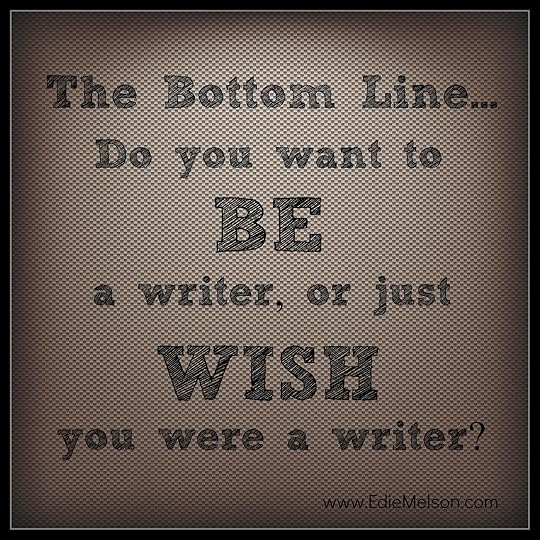
The bottom line is this—do you want to BE a writer or just WISH you were a writer? (click to tweet)
Here’s the opportunity to pony up. If you're willing to make the time to write, leave a comment below, along with your goal, if you'd like. Then we'll hold each other accountable!
Don't forget to join the conversation!Blessings,Edie
TWEETABLESAre excuses standing between you & your writing dreams? @EdieMelson offers steps to help move forward (Click to Tweet)
The excuses standing between you & time to write are just choices. @EdieMelson has tips to move forward (Click to Tweet)
 One of the most frustrating things for me when I’m approached by folks who want write is the litany of excuses that come up. I know, they’re not excuses, they’re reasons.
One of the most frustrating things for me when I’m approached by folks who want write is the litany of excuses that come up. I know, they’re not excuses, they’re reasons.Poppycock!
I don’t care what you call them, we all have them. We all have legitimate reasons not to do something. We’re all insanely busy—maybe not all in the same way—but trust me, we are equally bound up with to-do lists.
In case you think I’m being callous and unfeeling, let me assure you I’ve let these things keep me from writing. And one thing I’ve discovered is this—they’re not even reasons—they’re choices.
 Each of us has the same amount of time each day. Within each day we set our priorities. We decide where to spend our time. Sure there is some time that’s non-negotiable for everyone—eating, sleeping, for some working, for others being a parent.
Each of us has the same amount of time each day. Within each day we set our priorities. We decide where to spend our time. Sure there is some time that’s non-negotiable for everyone—eating, sleeping, for some working, for others being a parent.But we all have, what I like to call, disposable time. See if any of these strike a nerve:It’s that time when we choose to sleep in an extra 30 minutes instead of get up and write.It’s that time when we choose to stay up late instead of getting the sleep we need so we can get up 30 minutes early and write.It’s that time when we decide that closet needs cleaning out before we can get started.It’s that time when we choose lunch with a friend over writing.It’s that time when we watch TV instead of writing.It’s that time when we waste 30 minutes texting with a friend, rather than writing.It’s even the time when we decide we just don’t feel like writing.
The list goes on and on and on and on… We writers are a creative bunch, especially when it comes to manufacturing reasons not to write.
Following your dream takes sacrifice. It means treating your dream like it matters. Because it does! After all, how can you expect your family and friends to take you seriously if you don’t take yourself seriously.
 Here’s an exercise to help you weed out those excuses that plague us all:1. Make a list of all the things you HAVE to do. (Make sure they are truly have-tos, not should or want-tos. Those need to be weeded out. For example, I originally had vacuum the house weekly on my list. But I’ve learned that’s a should, not a have-to. Vacuuming every two weeks or delegating it to a family member works just as well.
Here’s an exercise to help you weed out those excuses that plague us all:1. Make a list of all the things you HAVE to do. (Make sure they are truly have-tos, not should or want-tos. Those need to be weeded out. For example, I originally had vacuum the house weekly on my list. But I’ve learned that’s a should, not a have-to. Vacuuming every two weeks or delegating it to a family member works just as well.2. Now make a list of things you’re willing to give up.
3. Now set a goal. I recommend you make it a weekly goal, instead of a daily one. That way when life happens (someone gets sick, the car dies, etc.) you have a little bit of grace time built in. The goal can be anything you want; a word count, a time goal, even a project goal. But write it down and put it someplace prominent. Make sure your family can see it as well as you.
4. Finally, share your goals with another writer. If you want, share it here.

The bottom line is this—do you want to BE a writer or just WISH you were a writer? (click to tweet)
Here’s the opportunity to pony up. If you're willing to make the time to write, leave a comment below, along with your goal, if you'd like. Then we'll hold each other accountable!
Don't forget to join the conversation!Blessings,Edie
TWEETABLESAre excuses standing between you & your writing dreams? @EdieMelson offers steps to help move forward (Click to Tweet)
The excuses standing between you & time to write are just choices. @EdieMelson has tips to move forward (Click to Tweet)
Published on July 10, 2014 01:00
July 9, 2014
World Blog Tour—Catching Up with Edie Melson
 Christian writers support and encourage one another by letting our readers know about other new writers they may like. We do this through blog tours.
Lori Stanley Roeleveld
invited me to answer four questions and then point you toward three authors whose work I support.
Christian writers support and encourage one another by letting our readers know about other new writers they may like. We do this through blog tours.
Lori Stanley Roeleveld
invited me to answer four questions and then point you toward three authors whose work I support. I’m trying to get more comfortable with Vlogging, so I’m going to answer these questions on video. (I’ll also post a recap below for those who don’t want to watch).
Next on the world blog tour, I’d like to introduce you to these writers:
 Ane Mulligan: Ane Mulligan is President of Novel Rocket. She writes Southern-fried fiction served with a tall, sweet iced tea. She's published dozens of plays, numerous articles, and humor columns. Her debut novel, Chapel Springs Revival releases Sept 8, 2014. She lives in Suwanee, GA with her artist husband, her chef son, and two shorthair wooly mammoths. To learn more about her, visit her website or follow her on Twitter, Facebook, or Pinterest.
Ane Mulligan: Ane Mulligan is President of Novel Rocket. She writes Southern-fried fiction served with a tall, sweet iced tea. She's published dozens of plays, numerous articles, and humor columns. Her debut novel, Chapel Springs Revival releases Sept 8, 2014. She lives in Suwanee, GA with her artist husband, her chef son, and two shorthair wooly mammoths. To learn more about her, visit her website or follow her on Twitter, Facebook, or Pinterest. Alycia Morales: Alycia Morales serves as an Associate Editor for Lighthouse Publishing of the Carolinas, is the Senior Editor of www.InspireAFire.com, and has successfully established her freelance editing business, Perfecting Pages Editing Service. In the three years she’s been active in the publishing business, she has edited best-selling and award-winning authors. Alycia is also an agented author with multiple published articles and devotions. She enjoys teaching at writers’ conferences across the United States and encouraging other writers to pursue their publishing dreams. She is a member of ACFW, The Christian PEN, and My Book Therapy. When she isn’t busy making others’ words shine and writing her own, she enjoys spending time with her husband and their four children as they move from state to state. To find more encouragement, join Alycia at her award-winning blog: www.alyciawmorales.com and on her editing blog with Andrea Merrill, The Write Editing.
Alycia Morales: Alycia Morales serves as an Associate Editor for Lighthouse Publishing of the Carolinas, is the Senior Editor of www.InspireAFire.com, and has successfully established her freelance editing business, Perfecting Pages Editing Service. In the three years she’s been active in the publishing business, she has edited best-selling and award-winning authors. Alycia is also an agented author with multiple published articles and devotions. She enjoys teaching at writers’ conferences across the United States and encouraging other writers to pursue their publishing dreams. She is a member of ACFW, The Christian PEN, and My Book Therapy. When she isn’t busy making others’ words shine and writing her own, she enjoys spending time with her husband and their four children as they move from state to state. To find more encouragement, join Alycia at her award-winning blog: www.alyciawmorales.com and on her editing blog with Andrea Merrill, The Write Editing. Andrea Merrill: Andrea Merrill has been writing for as long as she can remember, but her career took a serious turn about fifteen years ago when she and her husband attended a marriage retreat. One morning when the speaker asked about hobbies and passions, she mentioned writing. “Yes, and I’ll bet that’s at the bottom of your priority list,” was his response. When she admitted it was, he said, “Well, it’s time to get it off the bottom and put it on the top.” Then he leaned in a little closer and said, “After all, you’re not getting any younger, you know!” Andrea went home, started writing seriously, and has never turned back.
Andrea Merrill: Andrea Merrill has been writing for as long as she can remember, but her career took a serious turn about fifteen years ago when she and her husband attended a marriage retreat. One morning when the speaker asked about hobbies and passions, she mentioned writing. “Yes, and I’ll bet that’s at the bottom of your priority list,” was his response. When she admitted it was, he said, “Well, it’s time to get it off the bottom and put it on the top.” Then he leaned in a little closer and said, “After all, you’re not getting any younger, you know!” Andrea went home, started writing seriously, and has never turned back.She’s been published in various online venues and a number of anthologies. Her first book, Murder of a Manuscript: Writing and Editing Tips to Keep Your Book Out of the Editorial Graveyard , was released by Lighthouse Publishing of the Carolinas (LPC) in early 2014. Her next book, Praying for the Prodigal, will be released by LPC in 2015. She writes devotions for ChristianDevotions.us and CBN.com, and is currently working on three novels.
Besides her love of words and putting them on paper, Andrea loves to use her editing skills to help other writers become the best they can be. Being a newbie in the writing and publishing industry can be very intimidating, and she strives to be an encourager and mentor to those seeking to learn the trade and sharpen their skills. She is Associate Editor with Christian Devotions Ministries and Lighthouse Publishing of the Carolinas and has taught classes at Writers Advance Boot Camp, Kentucky Christian Writers Conference (KCWC), and the CLASS Christian Writers Conference. She is also a freelance editor and would love to help you get your manuscript ready for submission.
 Thank you to
Eddie Jones
for starting this World Blog Tour and for being a publisher who cares about furthering God’s kingdom through the ministry of the written word!
Thank you to
Eddie Jones
for starting this World Blog Tour and for being a publisher who cares about furthering God’s kingdom through the ministry of the written word!I'd love to know what you thought of the Vlog! Be sure to leave your thoughts in the comments section below.
Don't forget to join the conversation,Blessings,Edie
A Recap of the VlogWhat am I working on now? As always, several things. My agent, David Van Diest is helping me refine a couple of nonfiction ideas that a publisher has requested. I’m excited about this because nonfiction is where I began my career. These are all three ideas I’m passionate about and now I have the platform to be considered for these projects. As I look back on the past few years that I’ve spent growing my online presence, it’s gratifying to see that my work is beginning to bear fruit.
I’m also working on a Steampunk fiction project. I love Steampunk and I’m excited about the possibility that I can find a home for Steampunk in the Christian market.
Finally, as always, I’m blogging. This site has grown by leaps and bounds since I made the commitment to post seven days a week. I’m also super excited about my Guideposts blog for military families and the communities that minister to them. It can be found at www.Guideposts.org/blogs/While-They-S....
How does my work differ from others in it’s genre? I think that no matter what I write, my goal is to give people hope. Whether it’s the encouragement someone needs to start or stick with a writing career, the redemptive hope that underlies one of my fiction efforts, or the hope that a family facing deployment needs, it’s always present. I don’t know that this is different from others, a lot of writers speak from a foundation of hope.
Why do I write what I write? To paraphrase Isaac Asimov, because if I didn’t I’d die. Writing is how I process life. Beyond that, when God shares something with me, or I experience something that might help someone else, it seems to be the ultimate illustration of selfishness to keep it hidden.
How does my writing process work? Painfully? There’s no shortcut to the writing process, at least none that I’ve found. It’s a discipline that I’ve had to develop through years of practice. I used to believe that writers wrote from a place of inspiration. I think that inspiration helped us choose this path, and it definitely keeps us writing, but the process is so much more.
I’ve learned to write when I’m inspired and when I’m not. When I want to and when I don’t. When it brings joy and when it brings pain.
Published on July 09, 2014 01:00
July 8, 2014
Indie Tuesday—Characteristics of a Successful Indie Writer
by Edie Melson @EdieMelson
 Anyone can self-publish, but not everyone is comfortable the skill-set required to do it with excellence. Today, I’m going to highlight some of the things that prove you’ve got what it takes to be an indie writer. Some of these things apply to any publishing endeavor, but they’re an absolute must for self-publishing.
Anyone can self-publish, but not everyone is comfortable the skill-set required to do it with excellence. Today, I’m going to highlight some of the things that prove you’ve got what it takes to be an indie writer. Some of these things apply to any publishing endeavor, but they’re an absolute must for self-publishing.
General Writer CharacteristicsStory/book ideas that won’t leave you alone. The one thing I hear over and over again from writers is that a specific story and/or book idea won’t leave them alone. Those type of ideas echo in our minds and won’t leave until we commit them to paper.Characters in your mind that talk to you. This is a variation of the point above. Most writers have both characteristics, but as long as you have one, you’ll be able to succeed.
Indie Writer CharacteristicsA You can’t tell me what to do mind-set.Indie and Hybrid authors are notorious control freaks. This doesn’t mean that we reject valuable professional advice. But we always reserve the right to make the final decision regarding our project. A pioneer mindset.By this I mean the willingness to be on the cutting edge of publishing. We’re not mainstream, we’re blazing a trail for others to follow. This mindset holds that we are willing to risk failure for the sweet taste of success.The courage to try new things. The publishing industry is in a constant state of flux. This is especially true on the Indie side of the equation. That means success comes from trying things you’ve never done before. Beyond that, you have to be willing to spend the time and energyAn I’ll never give up attitude. This is vital for writers in general, but especially for Indie writers. A lot of times those authors who pursue a self-publishing course expect almost instant results. Occasionally things can happen fast, but far more often it’s a long-haul proposition. Giving up is the difference between success and failure.A love of books and the people who read them. Indie writers, especially those in the YA genre, have close ties with their readers. The most successful indie writers I meet are actively engaged with their audience.
A pioneer mindset.By this I mean the willingness to be on the cutting edge of publishing. We’re not mainstream, we’re blazing a trail for others to follow. This mindset holds that we are willing to risk failure for the sweet taste of success.The courage to try new things. The publishing industry is in a constant state of flux. This is especially true on the Indie side of the equation. That means success comes from trying things you’ve never done before. Beyond that, you have to be willing to spend the time and energyAn I’ll never give up attitude. This is vital for writers in general, but especially for Indie writers. A lot of times those authors who pursue a self-publishing course expect almost instant results. Occasionally things can happen fast, but far more often it’s a long-haul proposition. Giving up is the difference between success and failure.A love of books and the people who read them. Indie writers, especially those in the YA genre, have close ties with their readers. The most successful indie writers I meet are actively engaged with their audience.
Like everything in publishing, these aren’t hard and fast rules. The industry is littered with exceptions. But they’re called exceptions for a reason. So I’d love to know what you think. In your opinion, what characteristics are necessary for independent authors to succeed?
Don’t forget to join the conversation,Blessings,Edie
TWEETABLESDo you have what it takes to succeed as an #IndieAuthor? @EdieMelson has list to consider. (Click to Tweet)
Characteristics of a successful #IndieAuthor from @EdieMelson (Click to Tweet)
 Anyone can self-publish, but not everyone is comfortable the skill-set required to do it with excellence. Today, I’m going to highlight some of the things that prove you’ve got what it takes to be an indie writer. Some of these things apply to any publishing endeavor, but they’re an absolute must for self-publishing.
Anyone can self-publish, but not everyone is comfortable the skill-set required to do it with excellence. Today, I’m going to highlight some of the things that prove you’ve got what it takes to be an indie writer. Some of these things apply to any publishing endeavor, but they’re an absolute must for self-publishing.General Writer CharacteristicsStory/book ideas that won’t leave you alone. The one thing I hear over and over again from writers is that a specific story and/or book idea won’t leave them alone. Those type of ideas echo in our minds and won’t leave until we commit them to paper.Characters in your mind that talk to you. This is a variation of the point above. Most writers have both characteristics, but as long as you have one, you’ll be able to succeed.
Indie Writer CharacteristicsA You can’t tell me what to do mind-set.Indie and Hybrid authors are notorious control freaks. This doesn’t mean that we reject valuable professional advice. But we always reserve the right to make the final decision regarding our project.
 A pioneer mindset.By this I mean the willingness to be on the cutting edge of publishing. We’re not mainstream, we’re blazing a trail for others to follow. This mindset holds that we are willing to risk failure for the sweet taste of success.The courage to try new things. The publishing industry is in a constant state of flux. This is especially true on the Indie side of the equation. That means success comes from trying things you’ve never done before. Beyond that, you have to be willing to spend the time and energyAn I’ll never give up attitude. This is vital for writers in general, but especially for Indie writers. A lot of times those authors who pursue a self-publishing course expect almost instant results. Occasionally things can happen fast, but far more often it’s a long-haul proposition. Giving up is the difference between success and failure.A love of books and the people who read them. Indie writers, especially those in the YA genre, have close ties with their readers. The most successful indie writers I meet are actively engaged with their audience.
A pioneer mindset.By this I mean the willingness to be on the cutting edge of publishing. We’re not mainstream, we’re blazing a trail for others to follow. This mindset holds that we are willing to risk failure for the sweet taste of success.The courage to try new things. The publishing industry is in a constant state of flux. This is especially true on the Indie side of the equation. That means success comes from trying things you’ve never done before. Beyond that, you have to be willing to spend the time and energyAn I’ll never give up attitude. This is vital for writers in general, but especially for Indie writers. A lot of times those authors who pursue a self-publishing course expect almost instant results. Occasionally things can happen fast, but far more often it’s a long-haul proposition. Giving up is the difference between success and failure.A love of books and the people who read them. Indie writers, especially those in the YA genre, have close ties with their readers. The most successful indie writers I meet are actively engaged with their audience.Like everything in publishing, these aren’t hard and fast rules. The industry is littered with exceptions. But they’re called exceptions for a reason. So I’d love to know what you think. In your opinion, what characteristics are necessary for independent authors to succeed?
Don’t forget to join the conversation,Blessings,Edie
TWEETABLESDo you have what it takes to succeed as an #IndieAuthor? @EdieMelson has list to consider. (Click to Tweet)
Characteristics of a successful #IndieAuthor from @EdieMelson (Click to Tweet)
Published on July 08, 2014 01:00
July 7, 2014
Social Media Monday—T. H. I. N. K. Before You Share Online
by Edie Melson @EdieMelson
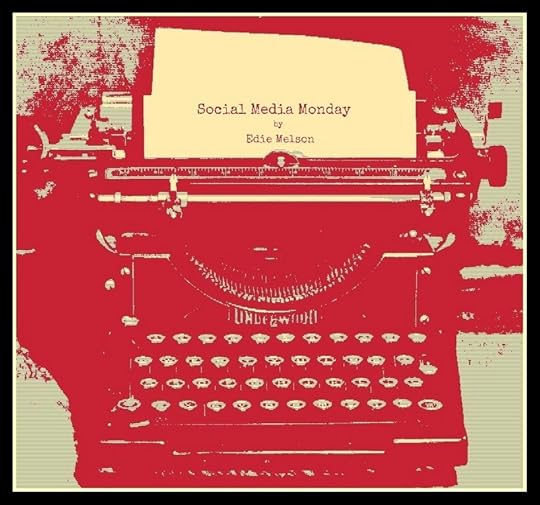 I didn’t always enjoy social media. Before I spent time on the various networks I assumed that interactions there were at best, shallow, with little or no real-world value. I’d formed my opinions by listening to the comments and complaints of others.
I didn’t always enjoy social media. Before I spent time on the various networks I assumed that interactions there were at best, shallow, with little or no real-world value. I’d formed my opinions by listening to the comments and complaints of others.
It wasn’t until I actually took time to interact online that I discovered there were lots of things of value being shared. The people I’ve met and the skills I’ve learned through online connections have added so much to my life—professionally and personally.
Unfortunately, I’ve also run across my fair share of time-wasting interactions. These have run the gamut of spam sales notices to misleading articles. But even these experiences have been, in a strange way, valuable. They’ve helped me develop my own set of guidelines to keep me from adding to the worthless noise that clutters up our digital universe. I think of these things as a series of filters that help me keep out any junk that might otherwise slip through. I call it my T. H. I. N. K. before you share online system.
Here’s how it works:T – Transparent. I want to be transparent in all that I do. I don’t want people who interact with me online—through social media or my blogs—to feel like I have a hidden agenda.
H – Honest. I don’t even want to mislead anyone on purpose. I don’t want to build myself up as something I’m not, or present myself in a way that isn’t true.
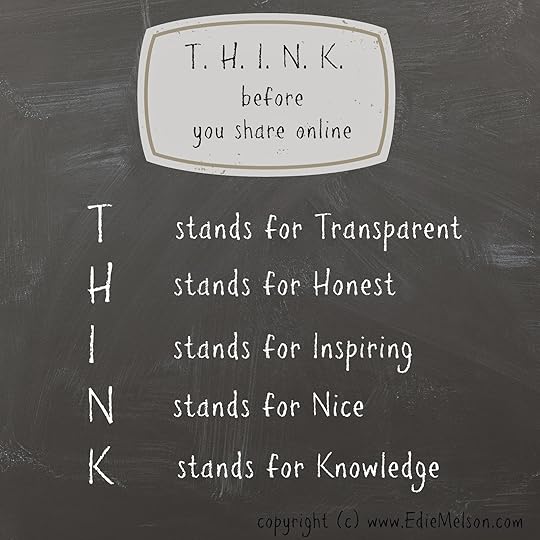 I – Inspiring. I want the things I share online to inspire others. I don’t mean I have to be the inspiration, but I want to challenge us all to do more than we ever thought we could.
I – Inspiring. I want the things I share online to inspire others. I don’t mean I have to be the inspiration, but I want to challenge us all to do more than we ever thought we could.
N – Nice. This poor little word is, in my opinion, under-utilized. I would like to see it regain some of it’s strength. There’s a lot to be said for being nice. And I try to hold to that standard with every single thing I post online. I can say this for certain, out of all the things in life I’ve regretted, being nice has never been one of them.
K – Knowledge. I want to make sure I’m sharing actual knowledge online, not just noise. This means what I share needs to be helpful in some way.
This filter hasn’t watered down my online message.
Quite the contrary. My online focus is stronger because I take care to filter it. I can still share things that may be tough, I can teach others to do what I’ve done, and I can introduce my online connections to people and things I find valuable.
Now it’s your turn. How do you decide what to share online? Be sure to leave your thoughts in the comments section below.
Don’t forget to join the conversation!Blessings,Edie
TWEETABLESHow do you decide what to share online thru #socialmedia& #blogging? @EdieMelson has a system to help (Click to Tweet)
T. H. I. N. K. Before You Share Online - a #socialmedia filter from @EdieMelson (Click to Tweet)
 I didn’t always enjoy social media. Before I spent time on the various networks I assumed that interactions there were at best, shallow, with little or no real-world value. I’d formed my opinions by listening to the comments and complaints of others.
I didn’t always enjoy social media. Before I spent time on the various networks I assumed that interactions there were at best, shallow, with little or no real-world value. I’d formed my opinions by listening to the comments and complaints of others.It wasn’t until I actually took time to interact online that I discovered there were lots of things of value being shared. The people I’ve met and the skills I’ve learned through online connections have added so much to my life—professionally and personally.
Unfortunately, I’ve also run across my fair share of time-wasting interactions. These have run the gamut of spam sales notices to misleading articles. But even these experiences have been, in a strange way, valuable. They’ve helped me develop my own set of guidelines to keep me from adding to the worthless noise that clutters up our digital universe. I think of these things as a series of filters that help me keep out any junk that might otherwise slip through. I call it my T. H. I. N. K. before you share online system.
Here’s how it works:T – Transparent. I want to be transparent in all that I do. I don’t want people who interact with me online—through social media or my blogs—to feel like I have a hidden agenda.
H – Honest. I don’t even want to mislead anyone on purpose. I don’t want to build myself up as something I’m not, or present myself in a way that isn’t true.
 I – Inspiring. I want the things I share online to inspire others. I don’t mean I have to be the inspiration, but I want to challenge us all to do more than we ever thought we could.
I – Inspiring. I want the things I share online to inspire others. I don’t mean I have to be the inspiration, but I want to challenge us all to do more than we ever thought we could.N – Nice. This poor little word is, in my opinion, under-utilized. I would like to see it regain some of it’s strength. There’s a lot to be said for being nice. And I try to hold to that standard with every single thing I post online. I can say this for certain, out of all the things in life I’ve regretted, being nice has never been one of them.
K – Knowledge. I want to make sure I’m sharing actual knowledge online, not just noise. This means what I share needs to be helpful in some way.
This filter hasn’t watered down my online message.
Quite the contrary. My online focus is stronger because I take care to filter it. I can still share things that may be tough, I can teach others to do what I’ve done, and I can introduce my online connections to people and things I find valuable.
Now it’s your turn. How do you decide what to share online? Be sure to leave your thoughts in the comments section below.
Don’t forget to join the conversation!Blessings,Edie
TWEETABLESHow do you decide what to share online thru #socialmedia& #blogging? @EdieMelson has a system to help (Click to Tweet)
T. H. I. N. K. Before You Share Online - a #socialmedia filter from @EdieMelson (Click to Tweet)
Published on July 07, 2014 01:00
July 5, 2014
A Fourth of July Meme
In honor of the Fourth of July holiday—

Share your thoughts in the comment section below.
I also invite you to use this image any way you like online. Post it to your blog, share it on Facebook, Twitter, Pinterest, anywhere you'd like. All I ask is that you keep it intact, with my website watermark visible.
Don't forget to join the conversation!Blessings,Edie

Share your thoughts in the comment section below.
I also invite you to use this image any way you like online. Post it to your blog, share it on Facebook, Twitter, Pinterest, anywhere you'd like. All I ask is that you keep it intact, with my website watermark visible.
Don't forget to join the conversation!Blessings,Edie
Published on July 05, 2014 01:00
July 4, 2014
As a Writer, Who's My Audience?
by Bruce Brady @bdbrady007
 Many unsuccessful and minimally successful writers have at least one thing in common, they write for and to themselves. While it’s okay to write for yourself, writing to yourself will greatly limit your potential audience—often to a crowd of one.
Many unsuccessful and minimally successful writers have at least one thing in common, they write for and to themselves. While it’s okay to write for yourself, writing to yourself will greatly limit your potential audience—often to a crowd of one.
It’s been my experience that people don’t want to read or hear me tell them what I want, they want what they want. And what they want is a story that captures their imaginations and satisfies their desires, not mine. The question is not what do I want to write about but to whom do I want to write? I must identify my target readers to have any hope of being read, heard, or published. I must find my audience.
 Let’s be clear, our audience doesn’t have to be a large group of people. It can be an audience of one. We can write to our spouse, our kids, another relative, a friend, or even a stranger whose character traits we only imagine. But it must be an audience other than ourselves.
Let’s be clear, our audience doesn’t have to be a large group of people. It can be an audience of one. We can write to our spouse, our kids, another relative, a friend, or even a stranger whose character traits we only imagine. But it must be an audience other than ourselves.
When writing to at least one clearly identified person, you’ll find many people can identify with that person. We all have moms and dads, most of us have siblings and other relatives, almost all of us have friends. For example, should you decide to write a story about how a brother and sister interact with one another, your potential readers include children and adults. Write about a married couple and you reduce your potential readership to include only married people and those who are considering marriage. Write About a familiar person or situation, there are people who’ll identify with and read your stories.
You may choose to write about someone or something you don’t know. This can be fun. When writing about an unknown someone—a character in your imagination—you become the creator. You get to invent your character’s personality traits and social environment. If it’s an unfamiliar subject, you’ll enjoy the pleasure of researching that subject or creating it. In both situations, you’ll engage others who share the same interest. Do it well enough, and you’ll have a very large audience.
The point is, if you write to someone other than yourself, you increase your audience of one to thousands, or even millions of readers who will relate to, and buy, your story.
Can you tell when a writer is writing to himself? I'd love to hear your thoughts. Be sure to leave them in the comments section below.
TWEETABLEIf you write to someone other than yourself, you increase your audience from 1 to 1000s - via @bdbrady007 (Click to Tweet)
When you write ask yourself this, "Who's my audience?" via @bdbrady007 (Click to Tweet)
 Bruce Brady is an author, writer and playwright. His work has appeared in Focus on the Family’s Thriving Family, www.ChristianDevotions.us, and on stage. Currently, Bruce is working on a Young Adult Novel about a boy who must deal with the death of his dad, being bullied, and helping his mom through her grief. His first five pages took third place in the ACFW South Carolina Chapter’s “First Five Pages” contest.
Bruce Brady is an author, writer and playwright. His work has appeared in Focus on the Family’s Thriving Family, www.ChristianDevotions.us, and on stage. Currently, Bruce is working on a Young Adult Novel about a boy who must deal with the death of his dad, being bullied, and helping his mom through her grief. His first five pages took third place in the ACFW South Carolina Chapter’s “First Five Pages” contest.
When he’s not writing, Bruce spends time learning from and helping other writers. He serves as Mentor of Word Weavers International’s Online Chapter, and as a member of Cross ‘N’ Pens, The Writer’s Plot, ACFW’s National and South Carolina Chapters.
“My dream is to entertain my readers and give them hope as they travel the rocky road of life.”
Connect with Bruce on his blog, The Write Voyage, Facebook, Twitter, Google+, and Pinterest.
 Many unsuccessful and minimally successful writers have at least one thing in common, they write for and to themselves. While it’s okay to write for yourself, writing to yourself will greatly limit your potential audience—often to a crowd of one.
Many unsuccessful and minimally successful writers have at least one thing in common, they write for and to themselves. While it’s okay to write for yourself, writing to yourself will greatly limit your potential audience—often to a crowd of one.It’s been my experience that people don’t want to read or hear me tell them what I want, they want what they want. And what they want is a story that captures their imaginations and satisfies their desires, not mine. The question is not what do I want to write about but to whom do I want to write? I must identify my target readers to have any hope of being read, heard, or published. I must find my audience.
 Let’s be clear, our audience doesn’t have to be a large group of people. It can be an audience of one. We can write to our spouse, our kids, another relative, a friend, or even a stranger whose character traits we only imagine. But it must be an audience other than ourselves.
Let’s be clear, our audience doesn’t have to be a large group of people. It can be an audience of one. We can write to our spouse, our kids, another relative, a friend, or even a stranger whose character traits we only imagine. But it must be an audience other than ourselves.When writing to at least one clearly identified person, you’ll find many people can identify with that person. We all have moms and dads, most of us have siblings and other relatives, almost all of us have friends. For example, should you decide to write a story about how a brother and sister interact with one another, your potential readers include children and adults. Write about a married couple and you reduce your potential readership to include only married people and those who are considering marriage. Write About a familiar person or situation, there are people who’ll identify with and read your stories.
You may choose to write about someone or something you don’t know. This can be fun. When writing about an unknown someone—a character in your imagination—you become the creator. You get to invent your character’s personality traits and social environment. If it’s an unfamiliar subject, you’ll enjoy the pleasure of researching that subject or creating it. In both situations, you’ll engage others who share the same interest. Do it well enough, and you’ll have a very large audience.
The point is, if you write to someone other than yourself, you increase your audience of one to thousands, or even millions of readers who will relate to, and buy, your story.
Can you tell when a writer is writing to himself? I'd love to hear your thoughts. Be sure to leave them in the comments section below.
TWEETABLEIf you write to someone other than yourself, you increase your audience from 1 to 1000s - via @bdbrady007 (Click to Tweet)
When you write ask yourself this, "Who's my audience?" via @bdbrady007 (Click to Tweet)
 Bruce Brady is an author, writer and playwright. His work has appeared in Focus on the Family’s Thriving Family, www.ChristianDevotions.us, and on stage. Currently, Bruce is working on a Young Adult Novel about a boy who must deal with the death of his dad, being bullied, and helping his mom through her grief. His first five pages took third place in the ACFW South Carolina Chapter’s “First Five Pages” contest.
Bruce Brady is an author, writer and playwright. His work has appeared in Focus on the Family’s Thriving Family, www.ChristianDevotions.us, and on stage. Currently, Bruce is working on a Young Adult Novel about a boy who must deal with the death of his dad, being bullied, and helping his mom through her grief. His first five pages took third place in the ACFW South Carolina Chapter’s “First Five Pages” contest.When he’s not writing, Bruce spends time learning from and helping other writers. He serves as Mentor of Word Weavers International’s Online Chapter, and as a member of Cross ‘N’ Pens, The Writer’s Plot, ACFW’s National and South Carolina Chapters.
“My dream is to entertain my readers and give them hope as they travel the rocky road of life.”
Connect with Bruce on his blog, The Write Voyage, Facebook, Twitter, Google+, and Pinterest.
Published on July 04, 2014 01:00
July 3, 2014
Thursday Review—Story Trumps Structure—A Writing Book for Everyone
by Lynn H. Blackburn @LynnHBlackburn
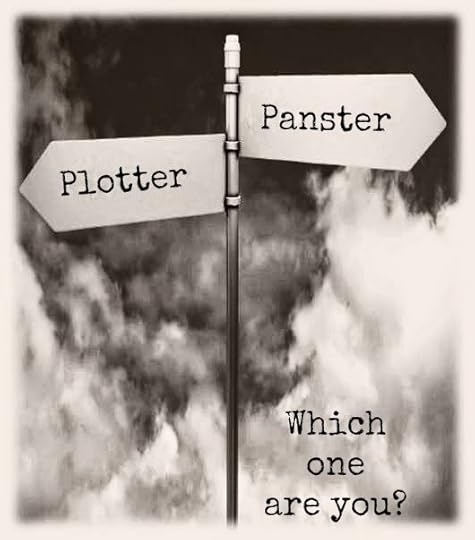 If you’ve been writing for any length of time, you’ve probably been asked the ever popular question, “What kind of writer are you?” What they want to know is are you an outliner or a pantster. Do you plan every scene in advance, or do you write organically and discover what happens along with your characters?
If you’ve been writing for any length of time, you’ve probably been asked the ever popular question, “What kind of writer are you?” What they want to know is are you an outliner or a pantster. Do you plan every scene in advance, or do you write organically and discover what happens along with your characters?
If you’re an outliner, you can find a plethora of books that will help you on your journey.
If you’re an organic writer? Not so much.
If you aren’t sure, join the club.
Regardless of how you do it, if you write fiction, Story Trumps Structure by Steven James is a worthy addition to your writing library.
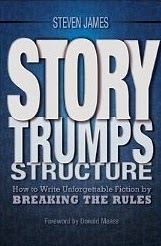 In the first half of the book, he explains the essence of story and why he believes organic writing is the best way to uncover the story. He discusses the “fiction of three acts” and the eight components that must be present at the beginning of a story. He shares his secrets to organic writing and includes several Q&As.
In the first half of the book, he explains the essence of story and why he believes organic writing is the best way to uncover the story. He discusses the “fiction of three acts” and the eight components that must be present at the beginning of a story. He shares his secrets to organic writing and includes several Q&As.
If you’re a diehard outliner, you may be thinking that this book isn’t for you. Don’t be so sure.
The last half of Story Trumps Structure was one of the most interesting and enlightening explanations of what it takes to write quality fiction I have ever read.
Regardless of how you approach your writing, the sections on Story Progression, The Narrative Forces that Shape Our Stories, The Subtleties of Characterization, and Plot Holes and How to Fix Them will strengthen your stories. There’s even a handy chart to help you troubleshoot problems you find in your plot and gives tips for how to fix them.
So how about you? Are you an outliner? An organic writer? Not sure?
Don’t forget to join the conversation!
TWEETABLESNeed a #writing book that helps you think outside the box? @LynnHBlackburn has one from @SJamesAuthor for you! (Click to Tweet)
STORY TRUMPS STRUCTURE, a #writing book by Steven James, @SJamesAuthor via @LynnHBlackburn (Click to Tweet)
 Lynn Huggins Blackburn has been telling herself stories since she was five and finally started writing them down. She blogs about faith, family, and her writing journey on her blog Out of the Boat. Lynn is a member of the Jerry B. Jenkins Christian Writers Guild and the Word Weavers, Greenville. She lives in South Carolina where she hangs out with three lively children, one fabulous man, and a cast of imaginary characters who find their way onto the pages of her still unpublished novels. She drinks a lot of coffee.
Lynn Huggins Blackburn has been telling herself stories since she was five and finally started writing them down. She blogs about faith, family, and her writing journey on her blog Out of the Boat. Lynn is a member of the Jerry B. Jenkins Christian Writers Guild and the Word Weavers, Greenville. She lives in South Carolina where she hangs out with three lively children, one fabulous man, and a cast of imaginary characters who find their way onto the pages of her still unpublished novels. She drinks a lot of coffee.
 If you’ve been writing for any length of time, you’ve probably been asked the ever popular question, “What kind of writer are you?” What they want to know is are you an outliner or a pantster. Do you plan every scene in advance, or do you write organically and discover what happens along with your characters?
If you’ve been writing for any length of time, you’ve probably been asked the ever popular question, “What kind of writer are you?” What they want to know is are you an outliner or a pantster. Do you plan every scene in advance, or do you write organically and discover what happens along with your characters?If you’re an outliner, you can find a plethora of books that will help you on your journey.
If you’re an organic writer? Not so much.
If you aren’t sure, join the club.
Regardless of how you do it, if you write fiction, Story Trumps Structure by Steven James is a worthy addition to your writing library.
 In the first half of the book, he explains the essence of story and why he believes organic writing is the best way to uncover the story. He discusses the “fiction of three acts” and the eight components that must be present at the beginning of a story. He shares his secrets to organic writing and includes several Q&As.
In the first half of the book, he explains the essence of story and why he believes organic writing is the best way to uncover the story. He discusses the “fiction of three acts” and the eight components that must be present at the beginning of a story. He shares his secrets to organic writing and includes several Q&As.If you’re a diehard outliner, you may be thinking that this book isn’t for you. Don’t be so sure.
The last half of Story Trumps Structure was one of the most interesting and enlightening explanations of what it takes to write quality fiction I have ever read.
Regardless of how you approach your writing, the sections on Story Progression, The Narrative Forces that Shape Our Stories, The Subtleties of Characterization, and Plot Holes and How to Fix Them will strengthen your stories. There’s even a handy chart to help you troubleshoot problems you find in your plot and gives tips for how to fix them.
So how about you? Are you an outliner? An organic writer? Not sure?
Don’t forget to join the conversation!
TWEETABLESNeed a #writing book that helps you think outside the box? @LynnHBlackburn has one from @SJamesAuthor for you! (Click to Tweet)
STORY TRUMPS STRUCTURE, a #writing book by Steven James, @SJamesAuthor via @LynnHBlackburn (Click to Tweet)
 Lynn Huggins Blackburn has been telling herself stories since she was five and finally started writing them down. She blogs about faith, family, and her writing journey on her blog Out of the Boat. Lynn is a member of the Jerry B. Jenkins Christian Writers Guild and the Word Weavers, Greenville. She lives in South Carolina where she hangs out with three lively children, one fabulous man, and a cast of imaginary characters who find their way onto the pages of her still unpublished novels. She drinks a lot of coffee.
Lynn Huggins Blackburn has been telling herself stories since she was five and finally started writing them down. She blogs about faith, family, and her writing journey on her blog Out of the Boat. Lynn is a member of the Jerry B. Jenkins Christian Writers Guild and the Word Weavers, Greenville. She lives in South Carolina where she hangs out with three lively children, one fabulous man, and a cast of imaginary characters who find their way onto the pages of her still unpublished novels. She drinks a lot of coffee.
Published on July 03, 2014 01:00
July 2, 2014
I Love Being a Writing Hermit
by Beth Ann Farley
 Are you a hermit? When I first took the leap of faith to leave my full time employment to stay home and heal my body, little did I know that God had more in store for me. I hated—not a very nice word—being home by myself. I missed people. I had worked in a very busy public library for many years and then boom; home to heal and be ALONE so much of the time.
Are you a hermit? When I first took the leap of faith to leave my full time employment to stay home and heal my body, little did I know that God had more in store for me. I hated—not a very nice word—being home by myself. I missed people. I had worked in a very busy public library for many years and then boom; home to heal and be ALONE so much of the time.
Each and every day, I would just sink deeper and deeper into depression because I missed my life. I had no routine. I had no desire to do anything. It wasn’t until I surrendered to God allowing Him to take hold of my life and teach me patience. During what felt like an eternity of adjusting to my new shut-in life, I had no idea that God was growing me into servant with my writing.
 During the healing process, I started reading the Word of God again and accepting each and every day for what it was. I found a great Bible Group to join, did a little bit of volunteer work but mostly became comfortable with being home honoring the silence of writing. I researched topics, made my plot cards, took my free writing classes, started a blog, and started submitting articles to various magazines. I became so comfortable that now I love being a writing HERMIT.
During the healing process, I started reading the Word of God again and accepting each and every day for what it was. I found a great Bible Group to join, did a little bit of volunteer work but mostly became comfortable with being home honoring the silence of writing. I researched topics, made my plot cards, took my free writing classes, started a blog, and started submitting articles to various magazines. I became so comfortable that now I love being a writing HERMIT.
 Is that okay? Is it okay to love being a writing hermit? I love being in my own zone. I love when my to do list consists only of writing. I love when everyone is gone, phone is off, sunshine is peeking in on my desk and I can retreat in my writing. However, I have to admit…It is NOT okay for me to be a hermit every day because I would forget the world around me. I would forget to enjoy live beyond the words.
Is that okay? Is it okay to love being a writing hermit? I love being in my own zone. I love when my to do list consists only of writing. I love when everyone is gone, phone is off, sunshine is peeking in on my desk and I can retreat in my writing. However, I have to admit…It is NOT okay for me to be a hermit every day because I would forget the world around me. I would forget to enjoy live beyond the words.
Like many writers, we gather our stories from our life experiences. I glean from other women who like to share. We can learn so much in life just by becoming part of life. After all, Jesus was more than a carpenter. He did not stay in his “shop” all day creating; just the opposite.
I read a quote from Jean Rook from Dressing for Success (1968):
One day a week, Sunday in my case, I believe in resting the skin. No foundation cream, no powder, but always eyeliner and mascara. Unless you don’t mind looking like a boiled egg. —Jean Rock
Now, if we can apply that to our writing lives: One day a week, believe in resting from the world. No pens, no computers, no paper, no deadlines; well maybe a little peak at your emails. Unless you do this you’ll end up looking like a “boiled-egg.” What does that even mean?
Don’t forget to come out of your writing shell and take in the world around you. You’ll be amazed at what words you’ll be excited to share about.
What are some ways you find to come out of your shell? Be sure to leave your thoughts in the comments section below.
TWEETABLESEven writing hermits need to come out of their shells occasionally! thoughts from Beth Ann Farley (Click to Tweet)
Are you a writing hermit? Don't forget to leave your shell every now and then - via Beth Ann Farley (Click to Tweet)
 Beth Ann Farley lives in Kansas City, MO with her husband and six grown children and 13 grandchildren. She has written for www.bookfun.org., Toot n’ Town magazine. She has recently been published with Landline magazine, Teachers in Focus, Horse & Rider, Mature Years, Indian Life and Wesleyan Publishing. Her poetry has been featured in Sweet Freedom written by Jennifer Slattery. She has been a guest blogger on thewriteconversation@blogspot.com by Edie Melson and Poppy Smith’s Inspiring Women to Thrive blog. Beth is a co-host on Living by Grace, a faith-based Facebook community. She often writes for the Senior Smart Network; a network devoted to senior citizens.
Beth Ann Farley lives in Kansas City, MO with her husband and six grown children and 13 grandchildren. She has written for www.bookfun.org., Toot n’ Town magazine. She has recently been published with Landline magazine, Teachers in Focus, Horse & Rider, Mature Years, Indian Life and Wesleyan Publishing. Her poetry has been featured in Sweet Freedom written by Jennifer Slattery. She has been a guest blogger on thewriteconversation@blogspot.com by Edie Melson and Poppy Smith’s Inspiring Women to Thrive blog. Beth is a co-host on Living by Grace, a faith-based Facebook community. She often writes for the Senior Smart Network; a network devoted to senior citizens.
Beth enjoys spending time with family and friends. She loves to tootle around the country side with her husband and their motorcycle. She loves reading, writing in her journal walking her little peek-a-poo named Peek-a-chew and engaging in Women’s’ Bible Studies.
Visit her online at: http://firsthalfday1.wordpress.com.
 Are you a hermit? When I first took the leap of faith to leave my full time employment to stay home and heal my body, little did I know that God had more in store for me. I hated—not a very nice word—being home by myself. I missed people. I had worked in a very busy public library for many years and then boom; home to heal and be ALONE so much of the time.
Are you a hermit? When I first took the leap of faith to leave my full time employment to stay home and heal my body, little did I know that God had more in store for me. I hated—not a very nice word—being home by myself. I missed people. I had worked in a very busy public library for many years and then boom; home to heal and be ALONE so much of the time.Each and every day, I would just sink deeper and deeper into depression because I missed my life. I had no routine. I had no desire to do anything. It wasn’t until I surrendered to God allowing Him to take hold of my life and teach me patience. During what felt like an eternity of adjusting to my new shut-in life, I had no idea that God was growing me into servant with my writing.
 During the healing process, I started reading the Word of God again and accepting each and every day for what it was. I found a great Bible Group to join, did a little bit of volunteer work but mostly became comfortable with being home honoring the silence of writing. I researched topics, made my plot cards, took my free writing classes, started a blog, and started submitting articles to various magazines. I became so comfortable that now I love being a writing HERMIT.
During the healing process, I started reading the Word of God again and accepting each and every day for what it was. I found a great Bible Group to join, did a little bit of volunteer work but mostly became comfortable with being home honoring the silence of writing. I researched topics, made my plot cards, took my free writing classes, started a blog, and started submitting articles to various magazines. I became so comfortable that now I love being a writing HERMIT. Is that okay? Is it okay to love being a writing hermit? I love being in my own zone. I love when my to do list consists only of writing. I love when everyone is gone, phone is off, sunshine is peeking in on my desk and I can retreat in my writing. However, I have to admit…It is NOT okay for me to be a hermit every day because I would forget the world around me. I would forget to enjoy live beyond the words.
Is that okay? Is it okay to love being a writing hermit? I love being in my own zone. I love when my to do list consists only of writing. I love when everyone is gone, phone is off, sunshine is peeking in on my desk and I can retreat in my writing. However, I have to admit…It is NOT okay for me to be a hermit every day because I would forget the world around me. I would forget to enjoy live beyond the words. Like many writers, we gather our stories from our life experiences. I glean from other women who like to share. We can learn so much in life just by becoming part of life. After all, Jesus was more than a carpenter. He did not stay in his “shop” all day creating; just the opposite.
I read a quote from Jean Rook from Dressing for Success (1968):
One day a week, Sunday in my case, I believe in resting the skin. No foundation cream, no powder, but always eyeliner and mascara. Unless you don’t mind looking like a boiled egg. —Jean Rock
Now, if we can apply that to our writing lives: One day a week, believe in resting from the world. No pens, no computers, no paper, no deadlines; well maybe a little peak at your emails. Unless you do this you’ll end up looking like a “boiled-egg.” What does that even mean?
Don’t forget to come out of your writing shell and take in the world around you. You’ll be amazed at what words you’ll be excited to share about.
What are some ways you find to come out of your shell? Be sure to leave your thoughts in the comments section below.
TWEETABLESEven writing hermits need to come out of their shells occasionally! thoughts from Beth Ann Farley (Click to Tweet)
Are you a writing hermit? Don't forget to leave your shell every now and then - via Beth Ann Farley (Click to Tweet)
 Beth Ann Farley lives in Kansas City, MO with her husband and six grown children and 13 grandchildren. She has written for www.bookfun.org., Toot n’ Town magazine. She has recently been published with Landline magazine, Teachers in Focus, Horse & Rider, Mature Years, Indian Life and Wesleyan Publishing. Her poetry has been featured in Sweet Freedom written by Jennifer Slattery. She has been a guest blogger on thewriteconversation@blogspot.com by Edie Melson and Poppy Smith’s Inspiring Women to Thrive blog. Beth is a co-host on Living by Grace, a faith-based Facebook community. She often writes for the Senior Smart Network; a network devoted to senior citizens.
Beth Ann Farley lives in Kansas City, MO with her husband and six grown children and 13 grandchildren. She has written for www.bookfun.org., Toot n’ Town magazine. She has recently been published with Landline magazine, Teachers in Focus, Horse & Rider, Mature Years, Indian Life and Wesleyan Publishing. Her poetry has been featured in Sweet Freedom written by Jennifer Slattery. She has been a guest blogger on thewriteconversation@blogspot.com by Edie Melson and Poppy Smith’s Inspiring Women to Thrive blog. Beth is a co-host on Living by Grace, a faith-based Facebook community. She often writes for the Senior Smart Network; a network devoted to senior citizens.Beth enjoys spending time with family and friends. She loves to tootle around the country side with her husband and their motorcycle. She loves reading, writing in her journal walking her little peek-a-poo named Peek-a-chew and engaging in Women’s’ Bible Studies.
Visit her online at: http://firsthalfday1.wordpress.com.
Published on July 02, 2014 01:00
July 1, 2014
Indie Tuesday—Ten Easy Ways To Show Tumblr Love
by Jessica Keller @AuthorKeller
 I'm switching gears today. Still talking about Social Media, but instead of only talking about how an author can use Tumblr, I'm going to share about how we as people who love to read and support other authors can do so in this medium. I've broken it down into ten easy ways to show Tumblr love to your favorite book/author. This is a repost from when I guest posted on the wonderful Kim Vandel's blog*
I'm switching gears today. Still talking about Social Media, but instead of only talking about how an author can use Tumblr, I'm going to share about how we as people who love to read and support other authors can do so in this medium. I've broken it down into ten easy ways to show Tumblr love to your favorite book/author. This is a repost from when I guest posted on the wonderful Kim Vandel's blog*
Tumblr is a place for microblogging amazingness. Not just a place—it’s THE place. One of the best things about Tumblr is that it has outlets for everyone. The blog platform includes photo sharing, written entries, video uploads, music sharing, a platform just for quotes, and the ability to post links. The best part of Tumblr is that it attracts creative people so books and stories are always welcome and reblogged. Unlike Twitter, you aren’t limited by a certain number of characters and you can use as many tags as you want. The latest Tumblr data shows that they host 187.0 million blogs. Don’t miss out on the fun we’re having over there!
The Top Ten for Tumblr
1)Follow the author on Tumblr and reblog their book news.
2) Post a countdown to release day for a book you’re looking forward. This can be as easy as doing a written post that just says “2 more days until BOOK NAME HERE—so excited!” Just like on Tumblr and Instagram, make sure to tag your posts with the title, author’s name, genre, and any other fun tags you can think of. #Got to have it, #ya lit, #fiction books, #reading
3) Share the book cover. Once you upload a picture you can click on it and add a clickable link. I always link book covers with their Amazon buy page so my followers can get their hands on a book I post right away if they want to. Make sure to tag it like you did the countdown and then add fun tags like #cover love, #so pretty
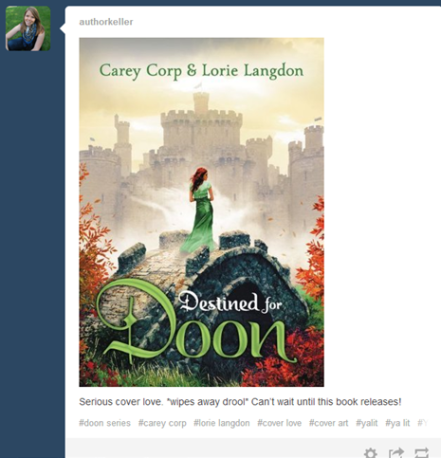
4) Create memes (did you know the rise of memes happened because of Tumblr?) about the book using quotes or pictures that remind you of the characters. When you upload it make sure to tag the author, the title, the genre and add meme: #ya lit meme
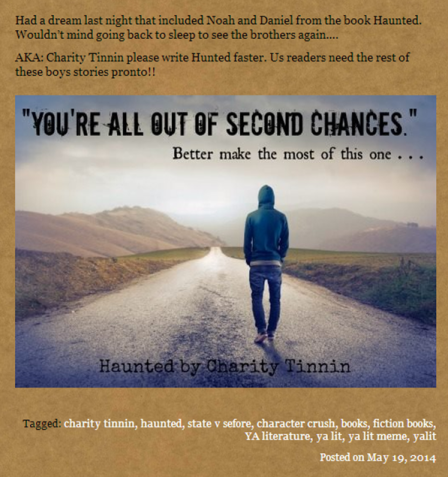
5) If you’re an artist then Tumblr is the ideal place to display your fan art. Draw a scene from the book or what you believe a character looks like. Authors love seeing fan art and will always reblog it. With your permission most of us print out fan art and use it to decorate our offices…if I’m being honest!
6) If the author (or someone else talking up the book) posts something book related, interact with them. Every time you respond that post is shared with your followers.
7) Upload a video of your reaction to the book. You can address the author in the video or act like you're talking to one of the characters. Anything goes with a reaction vlog. Just make sure to tag it appropriately.
8) If you love music you can make a playlist for the book and post songs that remind you of certain scenes or chapters or maybe a theme in the book. Tag music just like you would the rest of your posts.9) Take a photo of you holding the book when you first get it or a picture of your reading in your favorite spot. After tagging the photo with the author’s name, title, and genre think of other tags like #reading place #favorite place in the world #this book is so good10) Review the book. Tumblr doesn’t limit you on words so you can make the review as long or short as you want. If you read lots of books then you can become a Tumblr reviewer and be known for that. You can come up with your own “star system” of measuring how much you liked a book (but don’t use stars…use something unique, like a kiss-o-meter or jars of Nutella…mmm….I’d do that…this book is worth four jars of Nutella).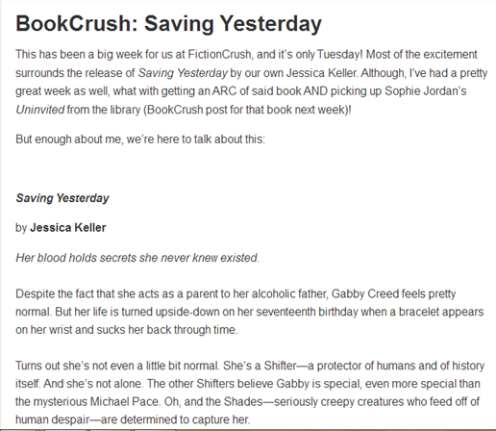 It's that easy!
It's that easy!
What are some ways you support and share about books you enjoyed using social media? Have you ever purchased a book based on a social media interaction?
TWEETABLES
Ten easy ways to show Tumblr love for your favorite book or author @AuthorKeller #Marketing (Click to Tweet)
Have you ever wondered how to use Tumblr? @AuthorKeller makes it easy. #Books #Marketing (Click to Tweet)
 Jessica Keller holds degrees in both Communications and Biblical Studies. She is multi-published in both Young Adult Fiction and Romance and has 100+ magazine and newspaper articles to her name. Her latest release is a Young Adult Fantasy -
Saving Yesterday
. You can find her at www.JessicaKellerBooks.com, on Twitter @AuthorKeller, on Tumblr, or on her Facebook Author Page. She lives in the Chicagoland suburbs with her amazing husband, beautiful daughter, and two annoyingly outgoing cats that happen to be named after superheroes.
Jessica Keller holds degrees in both Communications and Biblical Studies. She is multi-published in both Young Adult Fiction and Romance and has 100+ magazine and newspaper articles to her name. Her latest release is a Young Adult Fantasy -
Saving Yesterday
. You can find her at www.JessicaKellerBooks.com, on Twitter @AuthorKeller, on Tumblr, or on her Facebook Author Page. She lives in the Chicagoland suburbs with her amazing husband, beautiful daughter, and two annoyingly outgoing cats that happen to be named after superheroes.
 I'm switching gears today. Still talking about Social Media, but instead of only talking about how an author can use Tumblr, I'm going to share about how we as people who love to read and support other authors can do so in this medium. I've broken it down into ten easy ways to show Tumblr love to your favorite book/author. This is a repost from when I guest posted on the wonderful Kim Vandel's blog*
I'm switching gears today. Still talking about Social Media, but instead of only talking about how an author can use Tumblr, I'm going to share about how we as people who love to read and support other authors can do so in this medium. I've broken it down into ten easy ways to show Tumblr love to your favorite book/author. This is a repost from when I guest posted on the wonderful Kim Vandel's blog*Tumblr is a place for microblogging amazingness. Not just a place—it’s THE place. One of the best things about Tumblr is that it has outlets for everyone. The blog platform includes photo sharing, written entries, video uploads, music sharing, a platform just for quotes, and the ability to post links. The best part of Tumblr is that it attracts creative people so books and stories are always welcome and reblogged. Unlike Twitter, you aren’t limited by a certain number of characters and you can use as many tags as you want. The latest Tumblr data shows that they host 187.0 million blogs. Don’t miss out on the fun we’re having over there!
The Top Ten for Tumblr
1)Follow the author on Tumblr and reblog their book news.
2) Post a countdown to release day for a book you’re looking forward. This can be as easy as doing a written post that just says “2 more days until BOOK NAME HERE—so excited!” Just like on Tumblr and Instagram, make sure to tag your posts with the title, author’s name, genre, and any other fun tags you can think of. #Got to have it, #ya lit, #fiction books, #reading
3) Share the book cover. Once you upload a picture you can click on it and add a clickable link. I always link book covers with their Amazon buy page so my followers can get their hands on a book I post right away if they want to. Make sure to tag it like you did the countdown and then add fun tags like #cover love, #so pretty

4) Create memes (did you know the rise of memes happened because of Tumblr?) about the book using quotes or pictures that remind you of the characters. When you upload it make sure to tag the author, the title, the genre and add meme: #ya lit meme

5) If you’re an artist then Tumblr is the ideal place to display your fan art. Draw a scene from the book or what you believe a character looks like. Authors love seeing fan art and will always reblog it. With your permission most of us print out fan art and use it to decorate our offices…if I’m being honest!
6) If the author (or someone else talking up the book) posts something book related, interact with them. Every time you respond that post is shared with your followers.
7) Upload a video of your reaction to the book. You can address the author in the video or act like you're talking to one of the characters. Anything goes with a reaction vlog. Just make sure to tag it appropriately.
8) If you love music you can make a playlist for the book and post songs that remind you of certain scenes or chapters or maybe a theme in the book. Tag music just like you would the rest of your posts.9) Take a photo of you holding the book when you first get it or a picture of your reading in your favorite spot. After tagging the photo with the author’s name, title, and genre think of other tags like #reading place #favorite place in the world #this book is so good10) Review the book. Tumblr doesn’t limit you on words so you can make the review as long or short as you want. If you read lots of books then you can become a Tumblr reviewer and be known for that. You can come up with your own “star system” of measuring how much you liked a book (but don’t use stars…use something unique, like a kiss-o-meter or jars of Nutella…mmm….I’d do that…this book is worth four jars of Nutella).
 It's that easy!
It's that easy! What are some ways you support and share about books you enjoyed using social media? Have you ever purchased a book based on a social media interaction?
TWEETABLES
Ten easy ways to show Tumblr love for your favorite book or author @AuthorKeller #Marketing (Click to Tweet)
Have you ever wondered how to use Tumblr? @AuthorKeller makes it easy. #Books #Marketing (Click to Tweet)
 Jessica Keller holds degrees in both Communications and Biblical Studies. She is multi-published in both Young Adult Fiction and Romance and has 100+ magazine and newspaper articles to her name. Her latest release is a Young Adult Fantasy -
Saving Yesterday
. You can find her at www.JessicaKellerBooks.com, on Twitter @AuthorKeller, on Tumblr, or on her Facebook Author Page. She lives in the Chicagoland suburbs with her amazing husband, beautiful daughter, and two annoyingly outgoing cats that happen to be named after superheroes.
Jessica Keller holds degrees in both Communications and Biblical Studies. She is multi-published in both Young Adult Fiction and Romance and has 100+ magazine and newspaper articles to her name. Her latest release is a Young Adult Fantasy -
Saving Yesterday
. You can find her at www.JessicaKellerBooks.com, on Twitter @AuthorKeller, on Tumblr, or on her Facebook Author Page. She lives in the Chicagoland suburbs with her amazing husband, beautiful daughter, and two annoyingly outgoing cats that happen to be named after superheroes.
Published on July 01, 2014 00:30
June 30, 2014
Social Media Monday—What Gadgets Do I Need in My Blog’s Sidebar?
by Edie Melson @EdieMelson
 Someone contacted my with this question just last week. I looked for a blog post about this to send her. That's when I realized that while I talk about this in bits and pieces within different blog posts, I’ve never written a post addressing this specific issue.
Someone contacted my with this question just last week. I looked for a blog post about this to send her. That's when I realized that while I talk about this in bits and pieces within different blog posts, I’ve never written a post addressing this specific issue.
That’s a huge slip-up on my part because your blog’s sidebar is VERY important in the overall success of your site. Not just what's in it, but also what order those gadgets are in.
So today I’m going to break it down and answer the question, “What gadgets do I need in my blog’s sidebar?”Definition: Gadget, Widget, WhateverDepending on which blogging platform you use, the names of the plug-ins for your blog are different. Blogger: here they’re called Gadgets and you can find them by going to your Blogger dashboard and clicking on Layout. There are several pages, but stick with the tab that says BASIC. These (at the moment there are 28) gadgets have been vetted by Blogger and won’t secretly imbed some kind of Trojan horse bug into your blog. The BASIC gadgets are the only ones guaranteed. If you want to use any of the others, be sure to do your homework and verify they come from reputable sources and can’t have been tampered with.WordPress: here they’re called Widgets and you can find them by going to your blog’s dashboard and clicking on Appearance. WordPress has thousands of widgets, some free, some for sale. You can find Widget to fit a WordPress sight all over the Internet. Again, unless the Widget comes directly from WordPress, be sure to verify they come from reputable sources and can’t have been tampered with.
Blogger: here they’re called Gadgets and you can find them by going to your Blogger dashboard and clicking on Layout. There are several pages, but stick with the tab that says BASIC. These (at the moment there are 28) gadgets have been vetted by Blogger and won’t secretly imbed some kind of Trojan horse bug into your blog. The BASIC gadgets are the only ones guaranteed. If you want to use any of the others, be sure to do your homework and verify they come from reputable sources and can’t have been tampered with.WordPress: here they’re called Widgets and you can find them by going to your blog’s dashboard and clicking on Appearance. WordPress has thousands of widgets, some free, some for sale. You can find Widget to fit a WordPress sight all over the Internet. Again, unless the Widget comes directly from WordPress, be sure to verify they come from reputable sources and can’t have been tampered with.
Before I get to the specific gadgets you should include in your sidebar, let me give you some basic information about the purpose of that section of your blog. Your sidebar is first and foremost, your call to action for your reader. That isn’t just a sales term, but in this situation, it’s what you want your reader to do (like subscribe to your site or follow you on social media). Beyond that, the order you put your Gadgets in is their order of importance.
The gadget your readers sees first, is the most important thing. The one they see next is second in the list of importance, etc.
What Gadgets in What Order?Here are the two things I think every blog needs at the top of the sidebar: Subscription Links: this is where your reader can sign up for blog updates sent to their email or their RSS feed. You don’t need to know what an RSS feed is, but you do need to provide a way for your audience to get updates through a reader. For blogger, that gadget is the one labeled Subscription Links.Social Media Follow Buttons: These buttons are generally generated on the site of the platform you want to share. For example you have to go to Facebook to create your FB Follow or Like Button and Twitter to Create your Twitter button. That's the same no matter which site you want to link to, Instagram, LinkedIn, Pinterest, etc. Once you’ve followed the steps on the social media site and created the codes for your buttons, you’ll use the HTML Gadget to install them on your sidebar.
Subscription Links: this is where your reader can sign up for blog updates sent to their email or their RSS feed. You don’t need to know what an RSS feed is, but you do need to provide a way for your audience to get updates through a reader. For blogger, that gadget is the one labeled Subscription Links.Social Media Follow Buttons: These buttons are generally generated on the site of the platform you want to share. For example you have to go to Facebook to create your FB Follow or Like Button and Twitter to Create your Twitter button. That's the same no matter which site you want to link to, Instagram, LinkedIn, Pinterest, etc. Once you’ve followed the steps on the social media site and created the codes for your buttons, you’ll use the HTML Gadget to install them on your sidebar.
More GadgetsThere are lots of gadgets you can add to your site. You can also add them again and again, for different things. Most of them can be used multiple times. here are the things you might find helpful to include:The Blogging Schedule for My Site: I put this one close to the top and you won’t need this if you only post once or twice a week. For this I use the Text Gadget.Books I Have to Sell or PromoteBlogging ListMost Popular PostsLinks to Other Sites
Gadgets You Do NOT Need I don’t recommend you have the About Me information in a gadget. Instead I recommend you put that information into a Page on your blog.
I don’t recommend you have the About Me information in a gadget. Instead I recommend you put that information into a Page on your blog.
There are a lot of things you can add to your sidebar, but be careful. It’s important not to let your sidebar get too cluttered. Just add the things you need, as you need them.
Now it’s your turn, What questions do you have about your blog’s sidebar? Be sure to leave them in the comments section below.
Don’t forget to join the conversation!BlessingsEdie
TWEETABLESDo you know what gadgets you need in your blog’s sidebar?#SocialMedia Mentor @EdieMelson has the list for you (Click to Tweet)
It matters what gadgets you put where in your blog’s sidebar? #SocialMedia Mentor @EdieMelson says yes! (Click to Tweet)
 Someone contacted my with this question just last week. I looked for a blog post about this to send her. That's when I realized that while I talk about this in bits and pieces within different blog posts, I’ve never written a post addressing this specific issue.
Someone contacted my with this question just last week. I looked for a blog post about this to send her. That's when I realized that while I talk about this in bits and pieces within different blog posts, I’ve never written a post addressing this specific issue. That’s a huge slip-up on my part because your blog’s sidebar is VERY important in the overall success of your site. Not just what's in it, but also what order those gadgets are in.
So today I’m going to break it down and answer the question, “What gadgets do I need in my blog’s sidebar?”Definition: Gadget, Widget, WhateverDepending on which blogging platform you use, the names of the plug-ins for your blog are different.
 Blogger: here they’re called Gadgets and you can find them by going to your Blogger dashboard and clicking on Layout. There are several pages, but stick with the tab that says BASIC. These (at the moment there are 28) gadgets have been vetted by Blogger and won’t secretly imbed some kind of Trojan horse bug into your blog. The BASIC gadgets are the only ones guaranteed. If you want to use any of the others, be sure to do your homework and verify they come from reputable sources and can’t have been tampered with.WordPress: here they’re called Widgets and you can find them by going to your blog’s dashboard and clicking on Appearance. WordPress has thousands of widgets, some free, some for sale. You can find Widget to fit a WordPress sight all over the Internet. Again, unless the Widget comes directly from WordPress, be sure to verify they come from reputable sources and can’t have been tampered with.
Blogger: here they’re called Gadgets and you can find them by going to your Blogger dashboard and clicking on Layout. There are several pages, but stick with the tab that says BASIC. These (at the moment there are 28) gadgets have been vetted by Blogger and won’t secretly imbed some kind of Trojan horse bug into your blog. The BASIC gadgets are the only ones guaranteed. If you want to use any of the others, be sure to do your homework and verify they come from reputable sources and can’t have been tampered with.WordPress: here they’re called Widgets and you can find them by going to your blog’s dashboard and clicking on Appearance. WordPress has thousands of widgets, some free, some for sale. You can find Widget to fit a WordPress sight all over the Internet. Again, unless the Widget comes directly from WordPress, be sure to verify they come from reputable sources and can’t have been tampered with.Before I get to the specific gadgets you should include in your sidebar, let me give you some basic information about the purpose of that section of your blog. Your sidebar is first and foremost, your call to action for your reader. That isn’t just a sales term, but in this situation, it’s what you want your reader to do (like subscribe to your site or follow you on social media). Beyond that, the order you put your Gadgets in is their order of importance.
The gadget your readers sees first, is the most important thing. The one they see next is second in the list of importance, etc.
What Gadgets in What Order?Here are the two things I think every blog needs at the top of the sidebar:
 Subscription Links: this is where your reader can sign up for blog updates sent to their email or their RSS feed. You don’t need to know what an RSS feed is, but you do need to provide a way for your audience to get updates through a reader. For blogger, that gadget is the one labeled Subscription Links.Social Media Follow Buttons: These buttons are generally generated on the site of the platform you want to share. For example you have to go to Facebook to create your FB Follow or Like Button and Twitter to Create your Twitter button. That's the same no matter which site you want to link to, Instagram, LinkedIn, Pinterest, etc. Once you’ve followed the steps on the social media site and created the codes for your buttons, you’ll use the HTML Gadget to install them on your sidebar.
Subscription Links: this is where your reader can sign up for blog updates sent to their email or their RSS feed. You don’t need to know what an RSS feed is, but you do need to provide a way for your audience to get updates through a reader. For blogger, that gadget is the one labeled Subscription Links.Social Media Follow Buttons: These buttons are generally generated on the site of the platform you want to share. For example you have to go to Facebook to create your FB Follow or Like Button and Twitter to Create your Twitter button. That's the same no matter which site you want to link to, Instagram, LinkedIn, Pinterest, etc. Once you’ve followed the steps on the social media site and created the codes for your buttons, you’ll use the HTML Gadget to install them on your sidebar.More GadgetsThere are lots of gadgets you can add to your site. You can also add them again and again, for different things. Most of them can be used multiple times. here are the things you might find helpful to include:The Blogging Schedule for My Site: I put this one close to the top and you won’t need this if you only post once or twice a week. For this I use the Text Gadget.Books I Have to Sell or PromoteBlogging ListMost Popular PostsLinks to Other Sites
Gadgets You Do NOT Need
 I don’t recommend you have the About Me information in a gadget. Instead I recommend you put that information into a Page on your blog.
I don’t recommend you have the About Me information in a gadget. Instead I recommend you put that information into a Page on your blog.There are a lot of things you can add to your sidebar, but be careful. It’s important not to let your sidebar get too cluttered. Just add the things you need, as you need them.
Now it’s your turn, What questions do you have about your blog’s sidebar? Be sure to leave them in the comments section below.
Don’t forget to join the conversation!BlessingsEdie
TWEETABLESDo you know what gadgets you need in your blog’s sidebar?#SocialMedia Mentor @EdieMelson has the list for you (Click to Tweet)
It matters what gadgets you put where in your blog’s sidebar? #SocialMedia Mentor @EdieMelson says yes! (Click to Tweet)
Published on June 30, 2014 01:00



